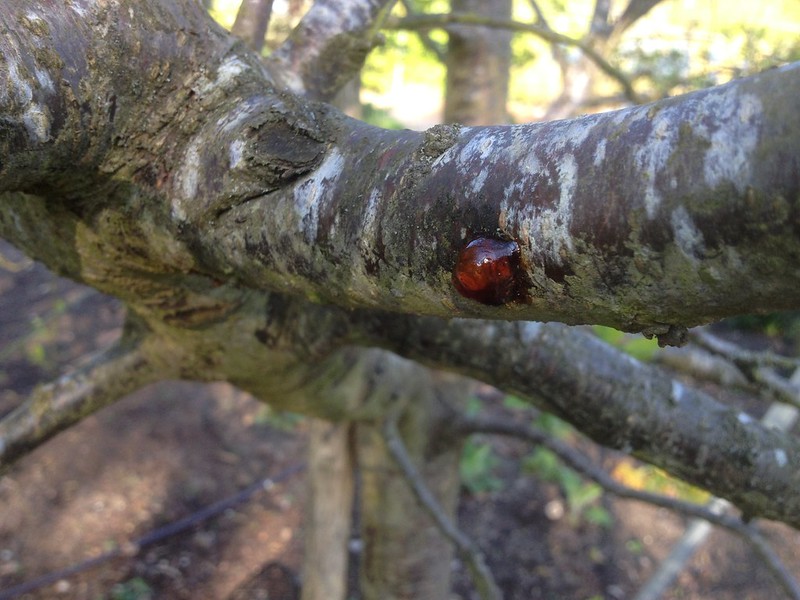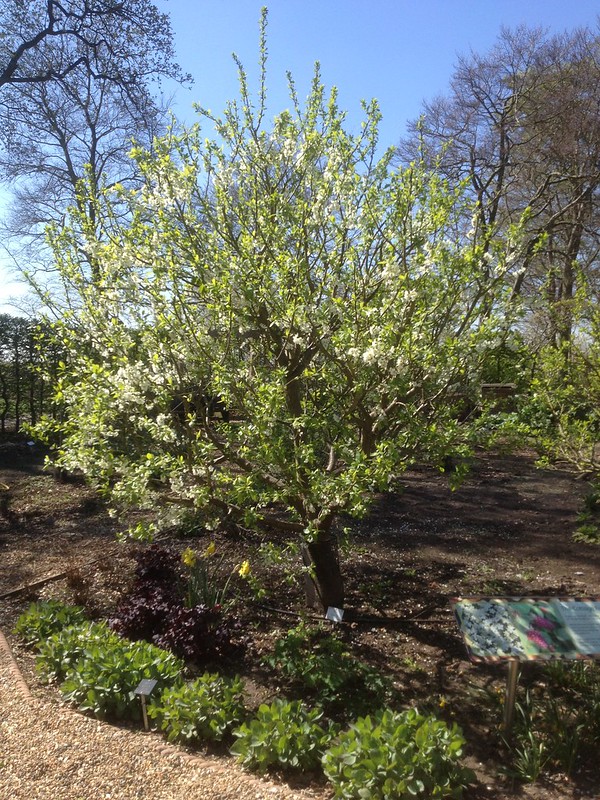To be precise, Prunus avium, or cherry trees, and P. domestica, the plums.
To be even more precise, the plants I'm referring to here are P. avium 'Sunburst', P. domestica 'Opal' and 'Blue Tit' ; and this last was flowering beautifully.
You don't normally prune Prunus when it's actually flowering, no - you either do it before or after, and that is generally for light formative pruning. That's what I had to confirm to the dozens of visitors that rightfully wondered what I was up to!
 |
| Branch removed as oozing gum is one sign of bacterial canker |
But this is indeed a good time of the year for pruning plums and cherries. And the fact we have been having a dry spell makes it a particularly valuable time for pruning, because Prunus are prone to fungal diseases such as silverleaf (Chondrostereum purpureum) and bacterial cankers (Pseudomonas syringae), which are promoted by humidity.
The best time for pruning Prunus, would be indeed a good August, a dry one, that is. But, as always in gardening, there is the best practice, and there are very real constraints, that require compromising for the second best: for example August is one of the busiest time of the year in a veg and fruit garden, while early April may be quieter, so one may actually get down to do what should be done for the health and productivity of the plant.
 |
| Our fruit specialist teaching with P. avium |
So, after some training by our specialist, I started on the Cottage Garden trees that needed a haircut, mostly a quick one, to give a pyramid shape and keep the height in check, so that cherries can be covered, for example (as that's the only way to save the fruits from birds) and picking is easier.
The principles being that you take big chunks, cutting back to a suitable branch (I was told in cherries you can sometimes leave stumps, much in the way of a Dutch cut but longer, to stimulate new growth): you cut back any new stems that are too long to 30 cm if they are leaders and some 20 cm if laterals. Keeping in as much flowers as possible is useful. Taking out any dead and diseased material to start with.
Acid cherries (P. cerasus) are slightly different in their growing habit, as they flower better on one year old wood, which (if left unmanaged for more than one year) causes long stems with flowers only at the top, that need replacement pruning to try and keep the shape compact.
But I did spend quite a while thinning out and taking some height out of the 'Blue Tit' tree, hence the opportunity for so many visitors to spot me on the ladder.
I am pretty satisfied with the result, there is a lot more air going through the plant, which should help with fungal diseases too. There are still a lot of flowers on, and the shape is pleasant from all sides.
 |  |
| Plum 'Blue Tit' before | Plum 'Blue Tit' after |
It seems a pity to throw away beautiful cherry blossom, the visitors pointed that out, but we did not waste it: we put the flowers in vases in the messroom to cheer us up, and I got some spare for the student accomodation too.

To prove it, here's me, once I got there, posing as "cherry blossom girl", in a picture I sent as a joke to my husband, as he likes a song by that name... he may have enjoyed the flowers a little bit too! ;p
Love the cherry blossom girl pic and so glad you put those beautiful blossoms to good use!
ReplyDelete